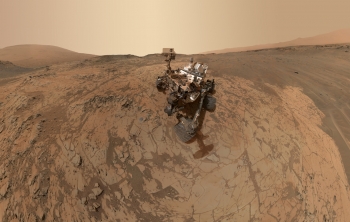
This self-portrait of NASA's Curiosity Mars rover shows the vehicle at the "Mojave" site on Mount Sharp, combining dozens of images taken in January 2015. The circle visible at the top of the rover's mast is part of the ChemCam instrument developed in part by Los Alamos National Laboratory. | Photo courtesy of NASA/JPL-Caltech/MSSS
This #SpaceWeek post is an update to our 2014 article about Curiosity's ChemCam, found here.
Don’t you hate it when your photos turn out blurry? Scientists at the Energy Department’s Los Alamos National Laboratory do. So when the ultra-precise camera they developed for NASA’s Mars Curiosity rover started going fuzzy, they came up with a solution that not only fixed the problem -- it made things clearer than ever.
Since Curiosity landed on Mars in 2012, the six-wheeled, Volkswagen-sized science laboratory has been busy drilling, zapping and snapping its way to a more complete understanding of the Red Planet’s past. One of its most useful tools is the ChemCam, a laser-camera combo that zaps rocks up to 25 feet away and analyzes the flashes to reveal traces of water and other elements in the Martian soil.
But last November, ChemCam’s auto-focus stopped working. Scientists back on Earth were forced to adopt a trial-and-error approach to get any useful data from the camera, taking nine images of each target at different focus levels: eight blurry, one (hopefully) in focus. “[It was] a rather poor return for the effort and time, but better than nothing,” said Roger Wiens, instrument lead at Los Alamos.
Meanwhile, the Los Alamos team went back to the drawing board. Their challenge: solve a hardware problem millions of miles from Earth using a software update the size of a short email.
They sifted through the code and realized that with a few tweaks, they could program ChemCam to take a range of images and automatically pick out the best focus on its own, saving time and even producing sharper images than before the malfunction. Following testing at Los Alamos, in France and at the Jet Propulsion Laboratory, NASA gave the green light to upload the fix in late May.
With ChemCam now working better than ever, the team has set its sights on a new piece of software that will let Curiosity choose and zap its own targets based on parameters set by mission scientists. That update is anticipated later this summer.




